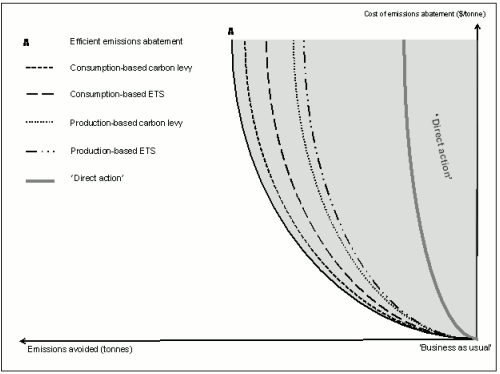‘Putting a price on carbon’ is shorthand for discouraging greenhouse gas emissions by making them expensive. Substantial resources are being diverted to this task.
The Climate Commission, the Multiparty Climate Committee, Ross Garnaut’s 2011 update of his 2008 Review, the Productivity Commission Inquiry into climate policy action in selected developed economies, and the ‘official family’ of Government Departments, are all working to devise and ‘sell’ the Government’s decision to ‘put a price on carbon’.
What’s the best way to ‘price carbon’? Who is looking at this question? None of the bodies listed above seems explicitly responsible for answering this question (for public consumption, anyway). Unless we know the answer to this question, anything is possible.
Advertisement
Any policy to reduce man-made greenhouse gas emissions ‘puts a price on carbon’. This includes ‘direct action’ options proposed by the Coalition, its unconvincing bluster on the topic notwithstanding.
Three key questions are relevant to determining ‘good’ policies for ‘putting a price on carbon’.
First, is the ‘price on carbon’ transparent (a feature extolled by the Government for the 13 February COAG deal on health funding still to be finalised in detail)?
Second, how will the trade-exposed sector of the economy be treated: via selective ‘special deals’, caving-in to ‘rent seekers’, or in a principled, comprehensive and consistent fashion?
Third, is the method chosen to ‘price carbon’ the most cost-effective option, maximising global emissions abatement for the cost involved?
Most politicians seemingly dislike transparent emissions pricing. That might imply consumers will end up paying most or all of the cost. (I note the Climate Commission head, Tim Flannery, to his credit, at least was not prepared to deny this reality in a recent TV interview.)
Advertisement
For the trade-exposed sector, a comprehensive, principled approach, cutting out ‘rent seekers’, ‘special pleaders’, and ‘green protectionists’ is crucial. The CPRS was poor process and policy in this respect.
That said, I think selecting just two trade-exposed industries for proper treatment, as suggested by Daley and Edis of the Grattan Institute (see Australian Financial Review 14 February) is both politically naïve and clearly non-comprehensive.
In my opinion, a broad-based price on national emissions consumption (see below) is likely to deliver the most cost-effective emissions abatement.
But the central issue is the policy process. Why isn’t an independent, qualified body, like the Productivity Commission, being asked to compile a cost-effectiveness ranking of options ‘putting a price on carbon’?
Politicians have shirked this basic task. The Government and the Coalition rejected a Senate Inquiry recommendation that various alternative options be tested in 2009. The Greens seemingly prefer that any and all mitigation policies be imposed, regardless of their cost-effectiveness.
Will the Government now commission a genuinely independent, qualified body, like the Productivity Commission, to review all options and produce a cost-effectiveness ranking of them?
The Shadow Minister for Communications called for a Productivity Commission review of the cost-effectiveness of the NBN project. Will the Opposition now call for a similar Productivity Commission cost-effectiveness review of greenhouse gas abatement policies, including ‘direct action’?
There are various private sector attempts to assess the cost-effectiveness of alternative options for pricing emissions, and many assertions by the Government about them as well.
Based on these, is it possible to provide a an illustrative ranking of options, as shown in Figure 1.
For a given technology bundle, there will be a maximum-efficiency national emissions abatement ‘frontier’ that will look something like the curved line ‘A’ in Figure 1. It is curved to show that reducing emissions becomes increasingly costly per tonne as the emissions task increases.

Figure 1.
Private sector analyses suggest that policies targeting national consumption of emissions (ie, excluding exports and including imports) are likely to be the most cost-effective, not least because they eliminate ‘carbon leakage’ due to industries shifting offshore. They require none of the ‘special deals’ likely under a national emissions production approach. A carbon tax or an emissions trading scheme could be used.
Policies targeting national production of emissions (ie, including exports and excluding imports) are likely to be less cost-effective, not least because they induce ‘carbon leakage’ due to industries shifting offshore. This also applies to a carbon tax or an emissions trading scheme.
One analysis suggests a national emissions consumption approach could cost up to 77% less in output losses per tonne of greenhouse gas emissions reduction than a national emissions production approach.
In general, ‘direct action’ options tend to be the least cost-effective. That is, they deliver the lowest emissions abatement for a given cost, or the same emissions abatement at the highest cost.
‘Putting a price on carbon’ should be done (i) transparently, (ii) with a comprehensive, principled approach to the trade-exposed sector (exports and imports), and (iii) using the most cost-effective policy.
The Government, (and the Coalition, Greens and others), should commission independent analysis to determine which option(s) best meet these criteria before deciding how to ‘put a price on carbon’.
Otherwise their policy credibility, and, as a result, their ability to ‘sell’ their policies, will be undermined.
Unless they base their policy choice on a principled, comprehensive approach to the trade-exposed sector, they will be unable to escape the morass of ‘special deals’ based on arbitrary thresholds that were a feature of the CPRS.
If we adopt an emissions trading scheme, all permits, without exception, should be auctioned to the highest bidders, provided the purchase costs are given the same treatment as input tax credits under the GST. This, plus World Trade Organisation-compliant border tax adjustments for imports, will ensure a consumption-based approach is put in place. No industry ‘compensation’ is warranted.
This approach is easier to implement using a carbon tax.